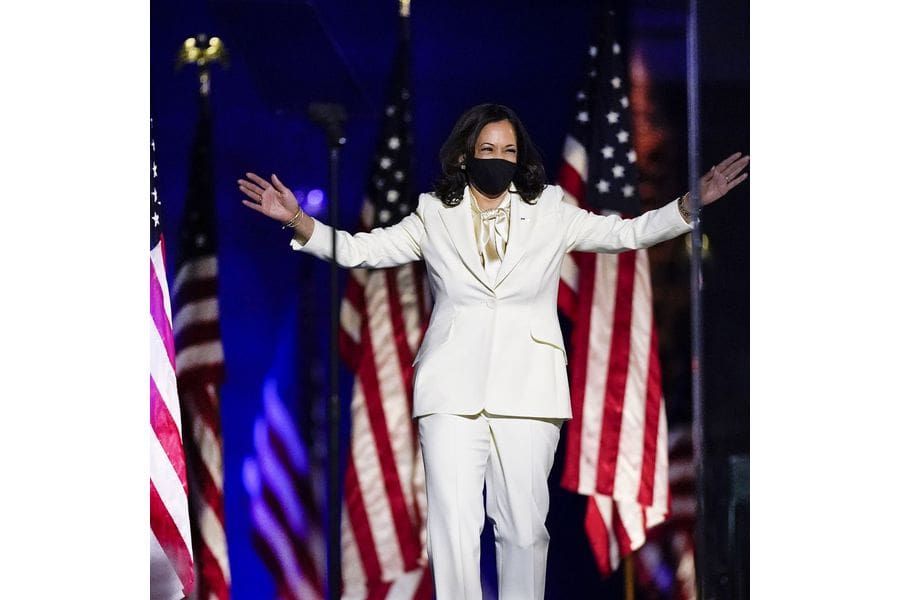Image via Vox.com Kamala Harris in a Carolina Herrera White Suit
The new vice president of the United States dressed in solidarity with the women in politics that came before her.
Kamala Harris took the stage Saturday, the 7th of November, in Wilmington, Delaware, to give a speech after being elected the next VP. It was clear that Harris understood the weight of her history-making victory, filled with many firsts for our country. Harris will be the first woman in the United States to become vice president, as well as the first Black vice president and the first Asian American vice president. For many in the U.S, this win signified the American Dream; the potential for anyone to be anything. Kamala Harris noted that “every little girl watching tonight sees that this is a country of possibilities.” She urged listeners to “dream with ambition, lead with conviction, and see yourself in a way that others might not see you, simply because they’ve never seen it before.” Social media surged with talk of Kamala Harris’s impactful speech and reflections of what her victory means for women and minorities in the United States. The internet was also alight dissecting the significance of Harris’s choice of outfit.
The Significance of Suffragette White
Kamala Harris’s sartorial choice for the speech was not as meaningless as it might first appear. Anyone familiar with the all-white outfit’s legacy in American politics knows it was once the uniform for suffragettes during the fight to get the vote. The color has a long and illustrious history of political use. It was adopted by Hilary Clinton in 2016 when she became the Democratic nominee, by Alexandria Ocasio-Cortez when she was sworn into Congress, and by Shirley Chisholm when she was the first African American woman elected to a seat in Congress in 1968. Women in Congress wore white during Trump’s State of the Union address in 2016 as a stance of solidarity with women and for women’s rights. Now, in 2020, Kamala Harris wore white as a way of acknowledging her place in a legacy of progress for women, noting in her speech that she was “stand[ing] on their shoulders” to make this historic victory possible.
It’s in the Details
Harris’s pantsuit was made by the American designer Wes Gordon for Carolina Herrera (a fashion house with a female American-immigrant founder). Harris paired the pantsuit with an ivory pussy-bow blouse, which has been worn in place of a tie for women in politics since the late British Prime Minister Margret Thatcher, the first female prime minister in England.
Color Theory
Wearing white pantsuits symbolized moral purity for the suffragettes, who wanted to appear unthreatening to those who believed their ideas were radical and dangerous. Today, it’s become a non-partisan symbol of peace in politics and was worn by Trump’s daughters, Ivanka and Tiffany, during their father’s inauguration. Although Tiffany wasn’t making history, Ivanka’s dual status as the daughter of the president and his political advisor was a first. Her sartorial choice led many to hope that the first daughters would advocate for women in the White House, which illustrates how powerful the symbol has become. It can be an effective way of communicating solidarity with barrier-breaking women in politics, even when no barriers are being broken.
As much of an eye-roll as it is to talk about what women in politics are wearing, clothing acts as a tool for political observers and contain cues that communicate who politicians are and what they stand for. For example, former President George W. Bush wore cowboy boots during events, which were meant to humanize him to the public, and suggested that he still felt strongly connected to his Texas upbringing, even while living in Washington, D.C.
Why Pay Attention to Political Fashion?
Why shouldn’t politicians make a sartorial statement when they can? People will analyze their outfits anyway—for better or worse. Take Melania Trump, for example, who wore a trench coat with “I Really Don’t Care” painted on the back while visiting a migrant child detention center. There are messages and meaning in our clothing—some not as oblivious and cold as Melania’s, but they’re there nonetheless.
Clothing is ultimately a strategy in politics. In an interview with Refinery29, historian and writer Dr. Jonathan Michael Square posed that “fashion is, thus, one of the most readily available political tools,” and that “even the decision not to care about fashion is a political statement.” Take Hilary Clinton’s relationship with her wardrobe as an example. She, like many other women in politics, disliked that the media payed far more attention to her fashion choices than to her male colleagues’s outfits. Clinton later embraced this seemingly shallow aspect of her candidacy as a strategy to make herself seem more relatable. She humorously posted a picture of her clothing rack, filled with multi-colored pantsuits, with a caption that read “Hard choices” as her first foray into Instagram. Embracing the attention her clothing gets became a way to take a second from the pressures of campaigning and crack a joke with her followers, which garnered her publicity and swayed public opinion in her favor.
The white pantsuit was Kamala Harris’s way to honor the women who came before her, and now, Harris will become a reference point for those who come after her—both in her leadership and sartorial choices. Harris’s decision to wear the white pantsuit was a unique opportunity to communicate how she perceives herself within the historical timeline of women in politics: her success is possible because of the work that came before her, and she is likewise paving the way for more and greater achievements for young women everywhere. As she said, she is “the first but not the last.”






